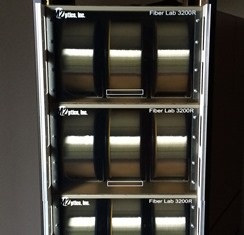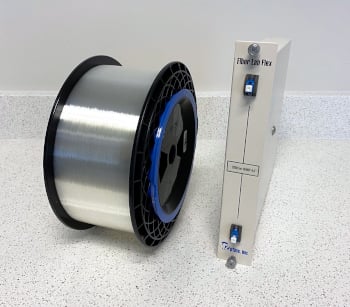For universities and research institutions developing, evaluating, and testing fiber optic technology to advance global communications, using optical fibers to accurately simulate span performance and latency in the lab is often an essential step in projects. This brief article discusses how customized Fiber Lab solutions from M2 Optics help researchers and professors successfully address the precision, consistency, and protection challenges that arise when working with bare optical fibers.
Challenge #1: Achieving Reliable Performance and Test Results
Handling bare, unjacketed optical fibers carries a high risk of damage to the fiber and connectors. Since most optical fibers are just slightly larger in diameter than a human hair, breaks occur very easily but even crimping the fiber will go unnoticed, but negatively impact performance.
The Fiber Lab Solution:
Every Fiber Lab solution is designed to house spools of bare fiber in a protected, efficient, and stable manner that produces reliable and repeatable performance results over the long term. Regardless of the type specified, every fiber is spooled to accurate lengths to the project needs, then quality verified to ensure the expected performance. Therefore, fiber performance for tests conducted today will match the performance of tests 6 months from today or longer. Additionally, Fiber Labs are built using the same high quality fiber types and brands (ex: Corning, OFS, Prysmian, Sumitomo, etc) that are deployed in networks, delivering performance results researchers can count on.
Challenge #2: Customization to Match Project Needs
The ever-evolving fiber optic technology arena requires researchers to adapt to the continuous introduction of new fibers, upgrades to existing ones, and employ different types to suit various project requirements. A one-size-fits-all approach to using fiber often does not apply, as research and project application goals vary significantly. As examples, a space application project may require the use of a specialty radiation-hardened fiber, while a terrestrial fiber application might be able to utilize a standard communications fiber. Alternatively, a fiber length with a precise distance tolerance may not be crucial for some applications, while a precision length may be the only objective in a latency-driven application. Fiber setup configurations change frequently, so the most effective solutions need to as well.
The Fiber Lab Solution
Recognizing that changing fiber needs require custom solutions when conducting research, M2 Optics offers a customizable approach with Fiber Lab solutions to deliver any fiber type, length, connector, enclosure, and overall setup configurations a user may require. Offering a complete portfolio of fiber types (including single mode, multimode, ribbon, or specialty), accurate lengths by distance or delay values, and numerous enclosure styles, M2 can build a Fiber Lab to suit any research needs for any lab environment. This comprehensive, tailored approach ensures researchers can receive exactly what they need for any given project, maximizing the value of their fiber investment.

Shown: 960km of Single Mode fiber in just 18RU total
Challenge #3: Protecting & Efficiently Organizing Fiber
The delicate nature of fiber demands protection, while properly organizing equipment in the lab is important to maximize physical space. In the hustle and bustle of a lab environment, accidents can happen, items are mishandled, and managing numerous fiber spools individually can become a major hassle as the quantity grows. Therefore, finding a better way to protect, store, and use optical fibers is a primary goal of many university and research labs.
Additionally, the look and aesthetics of a lab environment are important, especially if the lab hosts visitors. Universities and research centers take great pride in showcasing the facilities they have heavily invested in, so determining a best practice approach to fiber management should be included in the consideration process.
Fiber Lab Solution
Understanding that protecting and organizing fiber is extremely important for the user, Fiber Lab enclosures have been designed in a manner that addresses all of these considerations in a successful manner. As an example, aside from protecting the fiber and connectors from damage during use, many of the multi-spool rack-mount Fiber Lab solutions reduce physical space requirements by 50% or greater - a massive benefit to researchers seeking to maximize available lab space.

Shown: Fiber Lab Flex module with 25km saves over 65% physical space
Additionally, every fiber in a Fiber Lab is visually identified, so the researcher knows the exact fiber type and length they are connecting two. Bare optical fiber itself is unidentifiable simply by looking at the fiber itself, different manufacturers utilize different types of factory spools, and lengths are unknown without proper identification. By clearly identifying the fiber type and length, there is never a question of which fiber is being used, while significantly mitigating the risk that someone connects to an incorrect fiber which would provide inaccurate performance results.
Request Optical Fibers for a Research Project - Customized to Your Needs





